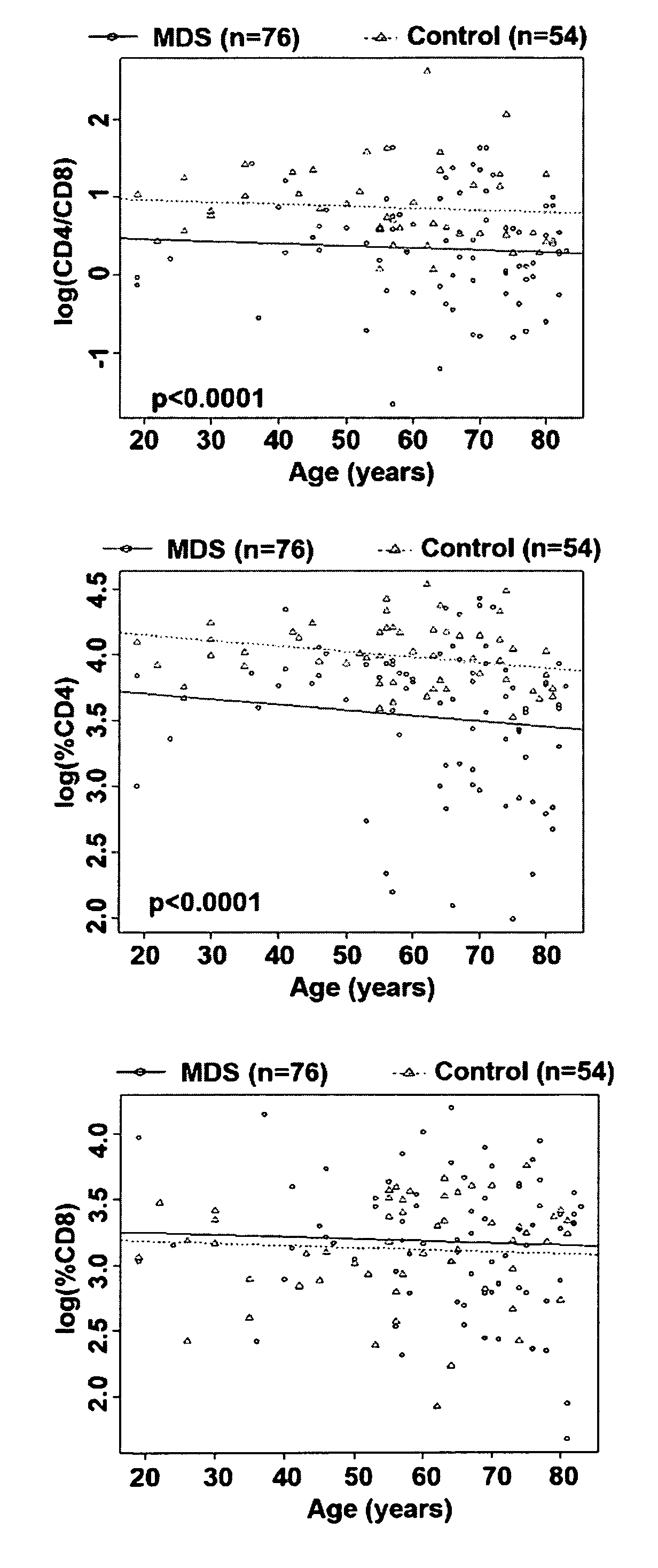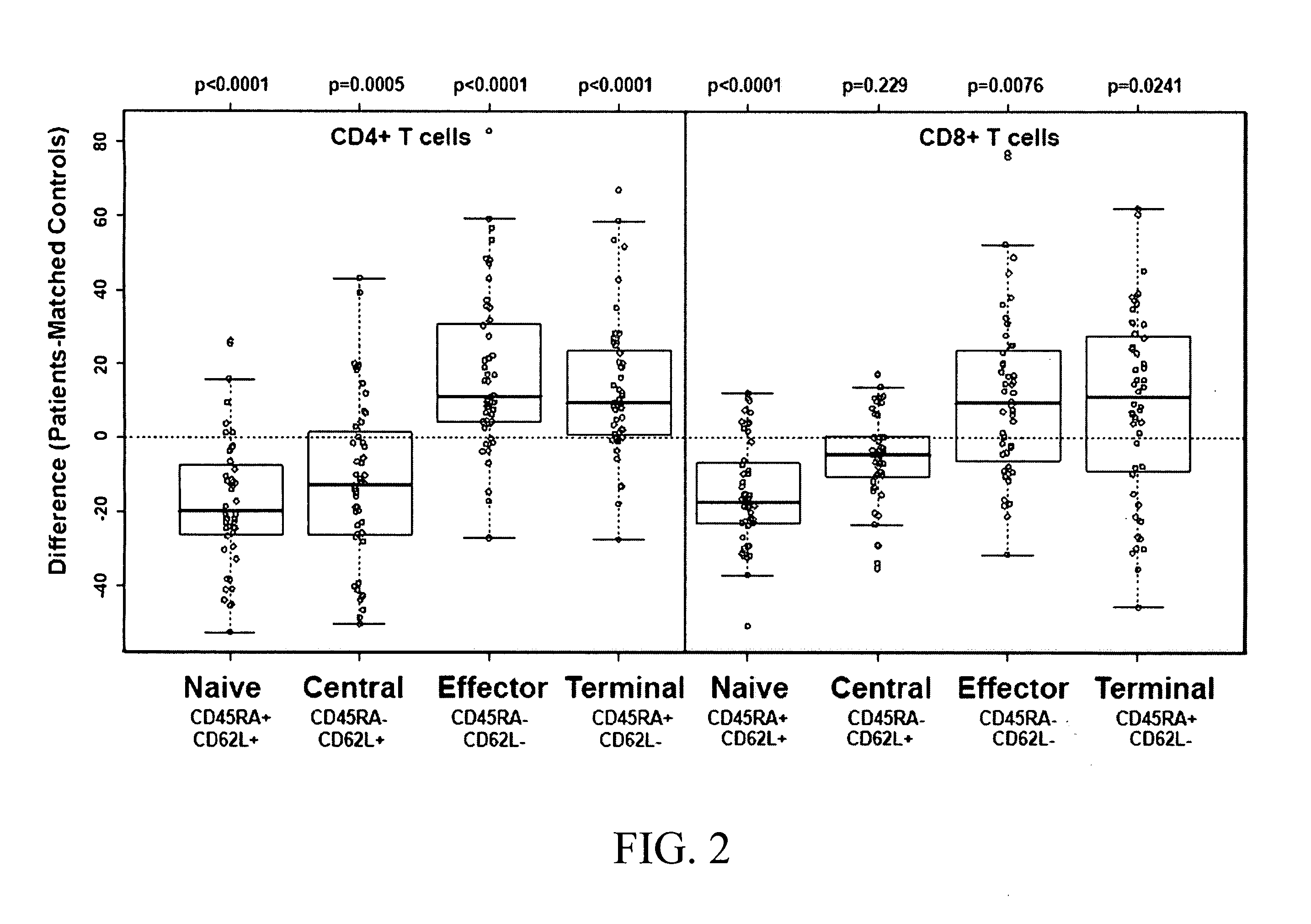Biomarkers for predicting response to immunosuppressive therapy
a technology of immunosuppressive therapy and biomarkers, which is applied in the direction of antibody medical ingredients, instruments, peptide/protein ingredients, etc., can solve the problems of negative impact on the risk of leukemia progression, and achieve the effect of increasing the likelihood of patient responsiveness to is
- Summary
- Abstract
- Description
- Claims
- Application Information
AI Technical Summary
Benefits of technology
Problems solved by technology
Method used
Image
Examples
example 1
Clinical Characteristics of MDS Patients
[0055]Characteristics of 76 untreated MDS patients (46 from Moffitt and 29 from NHLBI) are summarized in Table 1. Patient ages ranged from 19 to 82 years with a mean age of 64 years. Nearly half of the patients had refractory cytopenia with multilineage displasia (RCMD), and two thirds of all patients were low or intermediate-1 based on the IPSS. Half of the patients had abnormal karyotypes, including del[5q], trisomy 8, monosomy 7, and a complex karyotype with three or more abnormalities.
TABLE 1Characteristics of MDS patientsTotal (N)%Age2634.7(mean = 64 y.o.)=60 to =71 y.o.2432.0(n = 76)*>71 y.o.2533.3WHO**RA2035.1classificationRCMD2543.0(n = 57)RAEB1221.0IPSSLower (low / Int-1)3969.6(n = 56)Higher (Int-2 / High)1730.4KaryotypeNormal2748.2(n = 56)&Abnormal***3155.4del 5q4Trisomy 88Monosomy 72Complex13*A total of 76 patients were included in this study with a mean age of 64 years. All patients met the clinical criteria for myelodysplastic syn...
example 2
Reduced CD4:CD8 Ratio in MDS Patients
[0056]CD4+ T-cells are normally present in the peripheral blood lymphocyte pool at 2 to 4 times greater than that of CD8+ T-cells, and diminished CD4:CD8 ratio has been previously shown to correlate with poor survival outcome in MDS (Bennett & Komrokji, 2005; Sokol et al., 1989; Kook et al., 2001; Saunthararajah et al., 2001; Wang et al., 2006; Okamoto et al., 1997). Similar to previous reports, we found that the CD4:CD8 ratio was reduced in MDS patients compared to healthy controls after adjusting for age (p-value<0.0001) (FIG. 1A). To assess whether the case-control difference in the CD4:CD8 ratio was due to differences in CD4, CD8, or both, percentages of each cell type were individually compared between cases and controls after adjusting for age. This analysis revealed that the percentage of CD4 cells was reduced in the peripheral lymphocyte pool among MDS cases as compared to controls (FIG. 1B, p-value<0.0001), while there was no difference ...
example 3
T-Cell Subset Distribution is Defective in CD4+ and CD8+ T-Cells in MDS Patients
[0057]Since we found that CD4+ T-cells are diminished in MDS patients, and CD8+ T-cells have been shown to display TCR repertoire restriction, we examined the phenotype of both CD4+ and CD8+ T-cell populations in the same group of MDS cases and controls. Isoforms of the tyrosine phosphatase CD45 (RB, RA, RO), along with L-selectin (CD62L), have been used to distinguish naïve from memory T-cells (Rabin et al., 1995; Sallusto et al., 1999; De Rosa et al., 2001; Champagne et al., 2001). We used multiple color flow staining to distinguish the T-cell subpopulations. An illustration of these markers is shown in supplemental FIG. 1 for a healthy control donor. We compared the proportion of circulating naïve and memory CD4+ and CD8+ T-cell subpopulations in MDS patients (n=47) and healthy control donors, individually age-matched to MDS patients within 4 years (n=47). Data in FIG. 2 show that the percentages of n...
PUM
| Property | Measurement | Unit |
|---|---|---|
| Fraction | aaaaa | aaaaa |
| Fraction | aaaaa | aaaaa |
| Fraction | aaaaa | aaaaa |
Abstract
Description
Claims
Application Information
 Login to View More
Login to View More - R&D
- Intellectual Property
- Life Sciences
- Materials
- Tech Scout
- Unparalleled Data Quality
- Higher Quality Content
- 60% Fewer Hallucinations
Browse by: Latest US Patents, China's latest patents, Technical Efficacy Thesaurus, Application Domain, Technology Topic, Popular Technical Reports.
© 2025 PatSnap. All rights reserved.Legal|Privacy policy|Modern Slavery Act Transparency Statement|Sitemap|About US| Contact US: help@patsnap.com



